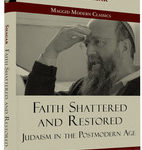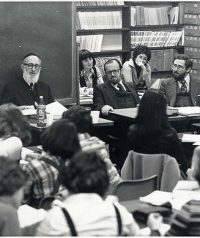Minhag and Halakhah in the Talmuds: A Cross-Cultural Study
BY: Rabbi Dr. Richard Hidary
This article will define the terms “Halakhah” and “Minhag” as used in Rabbinic literature, relate these concepts to their equivalents in secular legal theory, and analyze the relationship between the two as presented by the Talmud Yerushalmi and Bavli. The word Halakhah refers to a regulation or statement of law formulated by a legislator. The word Minhag, in both its nominal and verbal forms,
is used in rabbinic literature primarily to connote a habitual practice of laypeople that is related to but not directly legislated by Halakhah. This might be translated as “mere custom.” Generally, the rabbis recognize such customs as valid and generally encourage or require that their practice be continued, even though they are not officially legislated. In some cases, however, the practices of laypeople are considered mistaken by the rabbis because they have no basis in or even contradict the Halakhah. Rabbinic sources also use the term Minhag to describe the actual practice of laypeople regarding issues that have already been or are about to be legislated into Halakhah. In this sense, Minhag
could be translated as the widespread and commonly accepted form of the applied law. It is not always easy to distinguish which sense of the word Minhag
is used in any given text; that Hebrew uses the same word to mean “mere custom” as well as “widespread legal practice” shows that these categories are somewhat fluid.
Secular legal theorists have debated about the relationship between custom and legislated law. John Austin, a 19th-century British legal theorist, draws a strict distinction between custom, which has no legally binding authority since it is not explicitly commanded by the sovereign, and law, which incorporates custom only when officially legislated. Opposing this view is Friedrich Karl von Savigny, another 19th-century jurist, who expresses the view that custom arising from the spirit of the folk is valid law. James Coolidge Carter, arguing against the pro-codification position of Jeremy Bentham, both legal philosophers from 19th-century England, states in even more extreme terms: “Law, Custom, Conduct, Life – different names for almost the same thing – true names for different aspects of the same thing – are so inseparably blended together that one cannot even be thought of without the other.”
Rabbinic literature does not maintain a consistent position on the relationship between Minhag
and Halakhah. Many Talmudic passages do clearly distinguish between these categories and play down the importance of custom. Other passages legislate rules about how to deal with customs even at the stage when they are merely habitual practices, such as a stringency practiced by a small group with no precedent in Halakhah. These laws dictate which customs are acceptable, which customs are binding, who must keep them, when they can be changed, and how visitors to a place that keeps the custom should act. These passages maintain Minhag as a distinct realm of law but attribute to it a level of legal validity. Yet other passages – especially in the Yerushalmi – blend these categories together by using both Minhag
and Halakhah to describe the same law, pronouncing penalties for violating customs, and making explicit statements such as “Minhag mevattel Halakhah – custom nullifies law.”
Prior scholarship has noted the tendency throughout the Yerushalmi to define Halakhah by the common practice of the people. This is consistent with the general “ancient Palestinian approach,” which “placed a greater emphasis on the living, day-to-day tradition and a lesser emphasis on learned argumentation than did the Babylonian.” The Yerushalmi ascribes great importance to custom, which can sometimes trump official law. The Yerushalmi discourages any change in customs and seeks uniformity of custom within a locale. The Bavli, on the other hand, is more flexible in allowing people to change customs and also more often permits varieties of custom within a locale. Thus, the Yerushalmi’s view is closer to that of Savigny and Carter while the Bavli is closer to Austin and Bentham, although the positions of both of the Talmuds are much less extreme and systematic than those of the legal theorists.
The significance of custom in the Yerushalmi may be related to the Yerushalmi’s efforts at codification of Tannaitic dispute and the place of custom in Roman law. R. Yohanan, the most important sage in the Yerushalmi, institutes and disseminates a list of rules about how to decide between Tannaitic disputes in the Mishnah such as, “In a dispute between R. Yosei and his colleagues, the Halakhah accords with R. Yosei.” These rules are by and large followed throughout the Yerushalmi. By was of contrast, Rav Mesharsheya in the Bavli states: “These rules are to be disregarded.” The Bavli generally does not make an effort to adhere to these rules.
The penchant for codification in the Yerushalmi may be related to similar trends in Roman law during the late Principate and the Dominate. Roman law incorporated an increasingly large number of sources, beginning with the publication of the Twelve Tables in 450 BCE and continuing with subsequent legislation by various assemblies, magistrates, and, later on, imperial edicts and senatorial resolutions. This mass of laws that interpreted and sometimes even overturned preceding laws had grown unwieldy over time and place, prompting a sustained effort at codification beginning with Hadrian and culminating with Justinian’s Digest. This period from the second to the sixth centuries also saw the production of the Mishnah and the Talmud Yerushalmi. Previous scholars have noted parallels between Roman codes and the codificatory activity leading up to the publication of the Mishnah. Lee Levine doubts that it is mere coincidence that
“R. Akiva and his colleagues began collecting and organizing rabbinic traditions under Hadrian, when Julianus, Celsus Pomponius, and others were actively involved in making similar compilations in Rome,” and “Rabbi Judah the Prince compiled and edited his Mishnah, and tannaitic midrashim were collected under the Severans, at a time when Gaius, Papinianus, Paulus, and Ulpianus were likewise compiling codices and responsa of Roman law and commenting on earlier legal material.”
I would suggest that the link between Roman and halakhic codificatory activities extend even past the Mishnah. In 426 CE, Theodosius II and Valentinian III issued the “Law of Citations,” which “aspired to establish a veritable hierarchy for the opinions of celebrated jurists.” This law restated an earlier edict issued by Constantine in 321 C.E. that named five jurists (Gaius, Papinianus, Paulus, Ulpianus and Modestinus) as authorities whose codes should carry the most weight in court. However, the multiplicity of these divergent law codes themselves required further guidelines as to which code to follow. The Law of Citations thus stipulates:
“When conflicting opinions are cited, the greater number of the authors shall prevail, or if the numbers should be equal, the authority of that group shall take precedence in which the man of superior genius, Papinian, shall tower above the rest, and as he defeats a single opponent, so he yields to two.”
One must follow the majority of jurists. When they are equally split, then Papinian is to be followed over his four colleagues. This is similar to R. Yohanan‘s rules that also present a hierarchy of sages. Although the Law of Citations is codified later than the Talmudic parallels, it likely has roots in earlier Roman practice. The Law of Citations and other similar laws may very well have influenced not only R. Yohanan‘s penchant for uniform rules, but perhaps they even served as a model for the forms of these rules. This historical background may further explain why the rules gained widespread acceptance among the Amoraim in Erets Yisrael.
To be sure, there were also legal compilations made in Sasanian Persia during this period. Most significant is the Madayan i Hazar Dadestan (The Book of a Thousand Judgments), compiled c. 620 CE. While this book does quote from a number of previous sources and includes opinions of many jurists, there is no sustained effort at choosing between them, nor any general rules about how to decide between these authorities. The Madayan can therefore not be classified as a code. In fact, no legal code from Sasanian Babylonia has been preserved. It would seem that diversity of legal sources and opinions was not a major problem for the Sasanians and they therefore did not have to make concerted efforts at codification and unifying rules. Ironically, then, it is precisely the great diversity of Roman law that made their legists sensitive to the problems engendered by such diversity, and prompted them to codify and systematize their law. Sasanian law, apparently, did not face this challenge. The Babylonian rabbis would therefore also not feel pressure from their surrounding legal culture to codify their laws.
Roman law going back to the era of the Republic distinguished between ius scriptum and ius non scriptum (written law and unwritten law). Customs based on ancient traditions were part of the ius non scriptum and were “a source of norms which derived their binding force from the tacit consent of the people and their long-standing practice within the community.” Once Rome extended citizenship to all free inhabitants of its empire in 212 CE under the enactment of the constitutio Antoniniana, law became uniform for all citizens. However, this did not abolish the variety of local practices across various regions and cultures. Rather, as George Mousourakis points out,
“During the Dominate the role of custom as a supplementary source of law was further recognized. […] The centralization of law-making activity seems to have contributed, in an indirect way, to the enlargement of the role of custom as a source of law during this period.”
Thus, the program of unification and codification of Roman law begun by Hadrian paradoxically strengthened the importance of custom. The various communities throughout the Roman Empire did not simply abandon their previous laws and practices upon becoming citizens and reading a code that contradicted their own laws. Rather, many of these previous traditions now continued under the category of custom.
In a similar vein, the Yerushalmi’s emphasis on the importance of local custom may actually have resulted from its insistence on unity of law. Once one establishes that only one law may be valid, one still needs a way to justify the existence of variations of practice throughout pious rabbinic communities. Recognizing multiplicity of practice in the area of custom allows one to be more intolerant regarding multiple practices of law.
In conclusion, we have seen that the Talmud Yerushalmi places great emphasis on unity of law and so also attributes great importance to local customs as a mechanism for permitting diversity of practice within the strictures of a uniform Halakhah. The Bavli, on the other hand, is more tolerant of diversity of halakhic practice and therefore attributes less emphasis on the inviolability of custom. These differences between the Talmuds may, in some degree, relate to differences in the attitudes of the Amoraim of Erets Yisrael who emphasized the role of Halakhah in the practice of the common people, versus the Amoraim of Bavel who focused their attention on the Halakhah as defined in the learned argumentation of the beit midrash. The difference between the Talmuds may also be partially explained by differences in the surrounding legal cultures under the respective Roman and Sasanian Empires. We can follow the repercussions of the Talmudic discussions in the next centuries, with some Rishonim writing comprehensive codes of Halakhah and others criticizing projects of codification and preferring instead that local Rabbis should judge each case individually.
Questions of uniformity and custom take on greater complexity in modern times when communication dissolves borders and when most Jewish communities have been uprooted and joined together in America and Israel. R. Sabato Morais and R. Ben-Zion Meir Hai Uziel attempted to unify Ashkenazic and Sephardic liturgy and certain halakhic practices. Both rabbis were willing to compromise their own Sephardic traditions and practices for the sake of uniformity. Their pluralistic outlook thus opened the possibility for uniformity of practice. Conversely, Rabbi Abraham Isaac Kook and Rabbi Ovadia Yosef argued that Ashkenazim and Sephardim should each continue their prior practices because each considers the other’s laws to be in some way deficient. Their monism thus resulted in de facto pluralism. While the latter two sages seem to have won the day so far, we should bear in mind the various models offered in the Talmuds and by the Rishonim as our communities adapt to rapidly changing times.
Richard Hidary is an assistant professor of Judaic Studies at Stern College for Women and will be teaching a course next semester on pluralism and controversy in the Talmuds.






Minhag and Halakhah in the Talmuds: A Cross-Cultural Study
Minhag and Halakhah in the Talmuds: A Cross-Cultural Study
BY: Rabbi Dr. Richard Hidary
This article will define the terms “Halakhah” and “Minhag” as used in Rabbinic literature, relate these concepts to their equivalents in secular legal theory, and analyze the relationship between the two as presented by the Talmud Yerushalmi and Bavli. The word Halakhah refers to a regulation or statement of law formulated by a legislator. The word Minhag, in both its nominal and verbal forms,
is used in rabbinic literature primarily to connote a habitual practice of laypeople that is related to but not directly legislated by Halakhah. This might be translated as “mere custom.” Generally, the rabbis recognize such customs as valid and generally encourage or require that their practice be continued, even though they are not officially legislated. In some cases, however, the practices of laypeople are considered mistaken by the rabbis because they have no basis in or even contradict the Halakhah. Rabbinic sources also use the term Minhag to describe the actual practice of laypeople regarding issues that have already been or are about to be legislated into Halakhah. In this sense, Minhag
could be translated as the widespread and commonly accepted form of the applied law. It is not always easy to distinguish which sense of the word Minhag
is used in any given text; that Hebrew uses the same word to mean “mere custom” as well as “widespread legal practice” shows that these categories are somewhat fluid.
Secular legal theorists have debated about the relationship between custom and legislated law. John Austin, a 19th-century British legal theorist, draws a strict distinction between custom, which has no legally binding authority since it is not explicitly commanded by the sovereign, and law, which incorporates custom only when officially legislated. Opposing this view is Friedrich Karl von Savigny, another 19th-century jurist, who expresses the view that custom arising from the spirit of the folk is valid law. James Coolidge Carter, arguing against the pro-codification position of Jeremy Bentham, both legal philosophers from 19th-century England, states in even more extreme terms: “Law, Custom, Conduct, Life – different names for almost the same thing – true names for different aspects of the same thing – are so inseparably blended together that one cannot even be thought of without the other.”
Rabbinic literature does not maintain a consistent position on the relationship between Minhag
and Halakhah. Many Talmudic passages do clearly distinguish between these categories and play down the importance of custom. Other passages legislate rules about how to deal with customs even at the stage when they are merely habitual practices, such as a stringency practiced by a small group with no precedent in Halakhah. These laws dictate which customs are acceptable, which customs are binding, who must keep them, when they can be changed, and how visitors to a place that keeps the custom should act. These passages maintain Minhag as a distinct realm of law but attribute to it a level of legal validity. Yet other passages – especially in the Yerushalmi – blend these categories together by using both Minhag
and Halakhah to describe the same law, pronouncing penalties for violating customs, and making explicit statements such as “Minhag mevattel Halakhah – custom nullifies law.”
Prior scholarship has noted the tendency throughout the Yerushalmi to define Halakhah by the common practice of the people. This is consistent with the general “ancient Palestinian approach,” which “placed a greater emphasis on the living, day-to-day tradition and a lesser emphasis on learned argumentation than did the Babylonian.” The Yerushalmi ascribes great importance to custom, which can sometimes trump official law. The Yerushalmi discourages any change in customs and seeks uniformity of custom within a locale. The Bavli, on the other hand, is more flexible in allowing people to change customs and also more often permits varieties of custom within a locale. Thus, the Yerushalmi’s view is closer to that of Savigny and Carter while the Bavli is closer to Austin and Bentham, although the positions of both of the Talmuds are much less extreme and systematic than those of the legal theorists.
The significance of custom in the Yerushalmi may be related to the Yerushalmi’s efforts at codification of Tannaitic dispute and the place of custom in Roman law. R. Yohanan, the most important sage in the Yerushalmi, institutes and disseminates a list of rules about how to decide between Tannaitic disputes in the Mishnah such as, “In a dispute between R. Yosei and his colleagues, the Halakhah accords with R. Yosei.” These rules are by and large followed throughout the Yerushalmi. By was of contrast, Rav Mesharsheya in the Bavli states: “These rules are to be disregarded.” The Bavli generally does not make an effort to adhere to these rules.
The penchant for codification in the Yerushalmi may be related to similar trends in Roman law during the late Principate and the Dominate. Roman law incorporated an increasingly large number of sources, beginning with the publication of the Twelve Tables in 450 BCE and continuing with subsequent legislation by various assemblies, magistrates, and, later on, imperial edicts and senatorial resolutions. This mass of laws that interpreted and sometimes even overturned preceding laws had grown unwieldy over time and place, prompting a sustained effort at codification beginning with Hadrian and culminating with Justinian’s Digest. This period from the second to the sixth centuries also saw the production of the Mishnah and the Talmud Yerushalmi. Previous scholars have noted parallels between Roman codes and the codificatory activity leading up to the publication of the Mishnah. Lee Levine doubts that it is mere coincidence that
“R. Akiva and his colleagues began collecting and organizing rabbinic traditions under Hadrian, when Julianus, Celsus Pomponius, and others were actively involved in making similar compilations in Rome,” and “Rabbi Judah the Prince compiled and edited his Mishnah, and tannaitic midrashim were collected under the Severans, at a time when Gaius, Papinianus, Paulus, and Ulpianus were likewise compiling codices and responsa of Roman law and commenting on earlier legal material.”
I would suggest that the link between Roman and halakhic codificatory activities extend even past the Mishnah. In 426 CE, Theodosius II and Valentinian III issued the “Law of Citations,” which “aspired to establish a veritable hierarchy for the opinions of celebrated jurists.” This law restated an earlier edict issued by Constantine in 321 C.E. that named five jurists (Gaius, Papinianus, Paulus, Ulpianus and Modestinus) as authorities whose codes should carry the most weight in court. However, the multiplicity of these divergent law codes themselves required further guidelines as to which code to follow. The Law of Citations thus stipulates:
“When conflicting opinions are cited, the greater number of the authors shall prevail, or if the numbers should be equal, the authority of that group shall take precedence in which the man of superior genius, Papinian, shall tower above the rest, and as he defeats a single opponent, so he yields to two.”
One must follow the majority of jurists. When they are equally split, then Papinian is to be followed over his four colleagues. This is similar to R. Yohanan‘s rules that also present a hierarchy of sages. Although the Law of Citations is codified later than the Talmudic parallels, it likely has roots in earlier Roman practice. The Law of Citations and other similar laws may very well have influenced not only R. Yohanan‘s penchant for uniform rules, but perhaps they even served as a model for the forms of these rules. This historical background may further explain why the rules gained widespread acceptance among the Amoraim in Erets Yisrael.
To be sure, there were also legal compilations made in Sasanian Persia during this period. Most significant is the Madayan i Hazar Dadestan (The Book of a Thousand Judgments), compiled c. 620 CE. While this book does quote from a number of previous sources and includes opinions of many jurists, there is no sustained effort at choosing between them, nor any general rules about how to decide between these authorities. The Madayan can therefore not be classified as a code. In fact, no legal code from Sasanian Babylonia has been preserved. It would seem that diversity of legal sources and opinions was not a major problem for the Sasanians and they therefore did not have to make concerted efforts at codification and unifying rules. Ironically, then, it is precisely the great diversity of Roman law that made their legists sensitive to the problems engendered by such diversity, and prompted them to codify and systematize their law. Sasanian law, apparently, did not face this challenge. The Babylonian rabbis would therefore also not feel pressure from their surrounding legal culture to codify their laws.
Roman law going back to the era of the Republic distinguished between ius scriptum and ius non scriptum (written law and unwritten law). Customs based on ancient traditions were part of the ius non scriptum and were “a source of norms which derived their binding force from the tacit consent of the people and their long-standing practice within the community.” Once Rome extended citizenship to all free inhabitants of its empire in 212 CE under the enactment of the constitutio Antoniniana, law became uniform for all citizens. However, this did not abolish the variety of local practices across various regions and cultures. Rather, as George Mousourakis points out,
“During the Dominate the role of custom as a supplementary source of law was further recognized. […] The centralization of law-making activity seems to have contributed, in an indirect way, to the enlargement of the role of custom as a source of law during this period.”
Thus, the program of unification and codification of Roman law begun by Hadrian paradoxically strengthened the importance of custom. The various communities throughout the Roman Empire did not simply abandon their previous laws and practices upon becoming citizens and reading a code that contradicted their own laws. Rather, many of these previous traditions now continued under the category of custom.
In a similar vein, the Yerushalmi’s emphasis on the importance of local custom may actually have resulted from its insistence on unity of law. Once one establishes that only one law may be valid, one still needs a way to justify the existence of variations of practice throughout pious rabbinic communities. Recognizing multiplicity of practice in the area of custom allows one to be more intolerant regarding multiple practices of law.
In conclusion, we have seen that the Talmud Yerushalmi places great emphasis on unity of law and so also attributes great importance to local customs as a mechanism for permitting diversity of practice within the strictures of a uniform Halakhah. The Bavli, on the other hand, is more tolerant of diversity of halakhic practice and therefore attributes less emphasis on the inviolability of custom. These differences between the Talmuds may, in some degree, relate to differences in the attitudes of the Amoraim of Erets Yisrael who emphasized the role of Halakhah in the practice of the common people, versus the Amoraim of Bavel who focused their attention on the Halakhah as defined in the learned argumentation of the beit midrash. The difference between the Talmuds may also be partially explained by differences in the surrounding legal cultures under the respective Roman and Sasanian Empires. We can follow the repercussions of the Talmudic discussions in the next centuries, with some Rishonim writing comprehensive codes of Halakhah and others criticizing projects of codification and preferring instead that local Rabbis should judge each case individually.
Questions of uniformity and custom take on greater complexity in modern times when communication dissolves borders and when most Jewish communities have been uprooted and joined together in America and Israel. R. Sabato Morais and R. Ben-Zion Meir Hai Uziel attempted to unify Ashkenazic and Sephardic liturgy and certain halakhic practices. Both rabbis were willing to compromise their own Sephardic traditions and practices for the sake of uniformity. Their pluralistic outlook thus opened the possibility for uniformity of practice. Conversely, Rabbi Abraham Isaac Kook and Rabbi Ovadia Yosef argued that Ashkenazim and Sephardim should each continue their prior practices because each considers the other’s laws to be in some way deficient. Their monism thus resulted in de facto pluralism. While the latter two sages seem to have won the day so far, we should bear in mind the various models offered in the Talmuds and by the Rishonim as our communities adapt to rapidly changing times.
Richard Hidary is an assistant professor of Judaic Studies at Stern College for Women and will be teaching a course next semester on pluralism and controversy in the Talmuds.